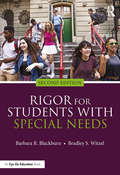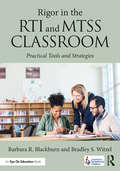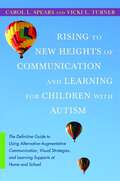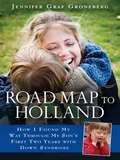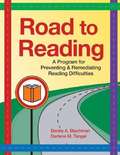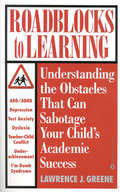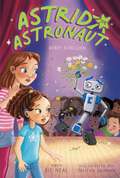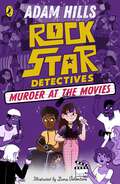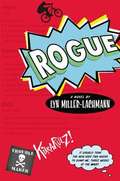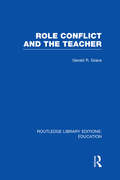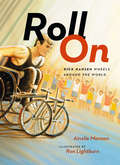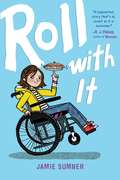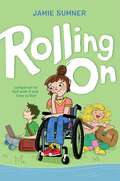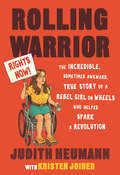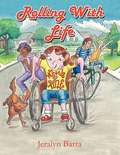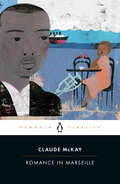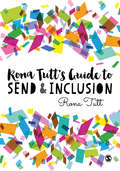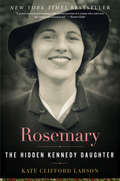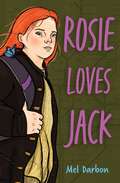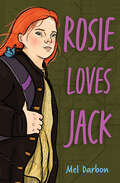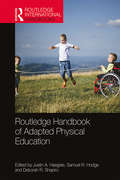- Table View
- List View
Rigor for Students with Special Needs
by Bradley S. Witzel Barbara R. BlackburnThis practical guide explains how to raise the rigor for students with special needs so they can achieve higher levels of learning. Bestselling author Barbara R. Blackburn and intervention expert Bradley S. Witzel provide helpful information on assessment, planning, co-teaching models, high expectations, common obstacles, and emphasizing positive outcomes. This second edition offers new, expanded instructional strategies for literacy and math, as well as strategies that work across subject areas. In addition, each chapter is filled with tools and examples to help you implement the ideas. Perfect for general and special educators and supervisors, the book also comes with a study guide so you can collaborate on the book with building or district colleagues. With the practical information in this book, you’ll understand how to teach with higher expectations and rigor so that all students can feel successful.
Rigor in the RTI and MTSS Classroom: Practical Tools and Strategies
by Barbara R. Blackburn Bradley Steven WitzelIn this new book, bestselling author Barbara R. Blackburn and intervention expert Bradley S. Witzel show you how to develop rigorous RTI and MTSS programs that will support students and lead them to lasting success. Written in a clear, engaging style, Rigor in the RTI and MTSS Classroom combines an in-depth discussion of the issues facing at-risk and learning-disabled students with practical strategies for all teachers. You’ll discover how to: Improve academic and social-emotional performance with scaffolding and demonstration of learning techniques; Establish and teach class rules, expectations, and consequences; Use evidence-based activities to spark student discussion; Implement rigorous, research-based strategies for math, literacy, reading, and writing development; Assess student growth and encourage self-reflection. Form an MTSS leadership team to ensure that student needs are met across building and district levels. Each chapter contains anecdotes from schools across the country as well as a variety of ready-to-use tools and activities. Many of the tools are offered as free eResources at www.routledge.com/9781138193383, so you can easily print and distribute them for classroom use.
Rising to New Heights of Communication and Learning for Children with Autism
by Carol L. Spears Vicki L. TurnerChildren with pervasive developmental disorders often do not learn from conventional methods, which can result in social isolation, behavior problems, limitations in communication, and slow academic growth. Greater integration into home and school activities, improved behavior and academic success can be achieved using alternative-augmentative communication (AAC), and this book explains exactly how to make it happen. Exploring the various communication and intervention options available and offering straightforward techniques and strategies for using them effectively, this book clearly explains everything families, teachers, therapists and other professionals need to know in order to improve a child's communication, behavior, social and academic skills. Chapters follow a consistent, user-friendly format, answering the questions Who, What, Why, How, Where and When about every technique. This book will be essential reading for anyone looking to improve social interaction between children with pervasive developmental disorders and those around them.
Rita Cheminais' Handbook for New SENCOs
by Rita CheminaisWith downloadable electronic resources Are you a new or trainee SENCO (Special Educational Needs Co-ordinator) looking for guidance? Do you have responsibility for your school's special educational needs (SEN) provision? Leading and co-ordinating SEN provision within a whole school is a mammoth task, and this book is your ultimate guide to getting it right. By breaking down the detailed information into manageable chunks, this book sets out the responsibilities of the SENCO and helps you make sure you are meeting the requirements of the SENCO Regulations. It is an invaluable guide for those working with children and young people from Birth to 19 in any setting. Chapters cover: - SEN, disability and Every Child Matters (ECM) legislation and policy - key elements of the National Award for SEN Coordination - coordinating SEN provision - planning and deploying the SEN budget - working in partnership with young people, parents and other professionals - leading, developing and supporting colleagues - record keeping and information management - provision mapping and management. Visit www. sagepub. co. uk/ritacheminais for downloadable materials to support the chapters in this book, which include templates, activities, a PowerPoint presentation, staff surveys and training plans. Suitable for new SENCOs and anyone responsible for SEN provision in their setting, this handbook will also be of interest to everyone involved with delivering the national SENCO training.
Road Map to Holland: How I Found My Way Through My Son's First Two Years With Down Symdrome
by Groneberg Jennifer GrafAn exceptional memoir that provides emotional insight and practical advice. It's like planning a trip to Italy, only to get off the plane and discover you're actually in Holland. You need a new road map, and fast. . . When Jennifer Groneberg and her husband learned they'd be having twin boys, their main concern was whether they'd need an addition on their house. Then, five days after Avery and Bennett were born, Avery was diagnosed with Down syndrome. Here, Jennifer shares the story of what followed. She dealt with doctors-some who helped, and some who were disrespectful or even dangerous. She saw some relationships in her life grow stronger, while severing ties with people who proved unsupportive. And she continues to struggle to find balance in the hardships and joys of raising a child with special needs. This book is a resource, a companion for parents, and above all, a story of the love between a mother and her son-as she learns that Avery is exactly the child she never knew she wanted. .
Road to Reading: A Program for Preventing and Remediating Reading Difficulties
by Benita A. Blachman Darlene M. TangelRoad to Reading provides a framework for providing both early intervention to prevent reading difficulties and remedial instruction for students who are struggling to learn to read.
Roadblocks to Learning: Understanding the Obstacles That Can Sabotage Your Child's Academic Success
by Lawrence J. GreeneThis comprehensive guide explains the symptoms and terminology associated with children who struggle in school because of underachievement and learning problems and offers parents practical solutions.Over seven million children suffer from learning difficulties. Most of these children are stuck in classrooms where their needs are not met or even recognized by an overcrowded school system. However, with the right information and diagnostic tools, parents can provide life-long learning skills specially targeted to their childrens needs. This book lays out the symptoms, terms, and trategies parents will encounter if their child has a learning block and explains how to convey their childs needs and condition to teachers. Categorized and cross-referenced for easy access, ROADBLOCKS TO LEARNING covers over 70 different obstacles to learning. From study skills to ADD, from problem solving to teacher-child conflict, this indispensable guide is for all parents who want to ensure their child is learning to his/her full potential.
Robot Rebellion (Astrid the Astronaut #4)
by Rie NealThis is the fourth book in the Astrid the Astronaut chapter book series about a young girl determined to be the first hard-of-hearing astronaut in space!When Astrid and the rest of the Shooting Stars find out that their teacher, Ms. Ruiz, is about to celebrate a big birthday, they band together to create the perfect gift. Her big day happens to be the same as the upcoming robotics competition and they decide to do something there. With the help of Astrid&’s big sister, Stella, they program their robot to do a fun dance and give Ms. Ruiz a sweet surprise. But on the day of the competition, the data for the Shooting Stars robot somehow gets mixed up with another one! Will their fun present end up being a major malfunction?
Rockstar Detectives: Murder at the Movies (Rockstar Detectives #2)
by Adam HillsThe brilliant and laugh-out-loud second mystery from comedian Adam Hills featuring a young detective dream team. The perfect read for fans of Sharna Jackson, Robin Stevens and David Baddiel!Meet Charley - a totally ordinary 13-year-old, who's also an international singing sensation.Meet George - Charley's best friend, social media whizz, and budding comedian.Charley and George are in Sydney, where Charley is filming her first movie. But when mysterious accidents begin to happen whenever Charley's on set, the duo suspect someone isn't as excited about her big screen debut as they are . . .No one else seems to believe that Charley's in real danger and anyone - from the bad-tempered director to Charley's rude co-star - could be a suspect. Can the detective dream team solve their second mystery, wrap the movie - and keep Charley in one piece?The fabulously funny new novel from award-winning comedian and author of ROCKSTAR DETECTIVES, Adam Hills.Praise for the first book in the ROCKSTAR DETECTIVES series:'A delightfully funny book with a big, big heart' - David O'Doherty'Fast-moving, lively, full of jokes and humour and with a satisfying puzzle to be solved, this makes for perfect escapist reading' - LoveReading4Kids
Rocky Mountain Match
by Pamela NissenWhen blindness strikes carpenter Joseph Drake, the prospect of a lifetime of darkness fills him with despair. But then his brother hires Katie Ellickson. The strong-willed, confident teacher knows what it's like to be outcast, alone--and she won't give up on Joseph, even when he's ready to give up on himself. He thinks blindness is his most difficult obstacle, until he finds a bigger challenge--trying to reach Katie's heart. Will she let him? Katie has secrets that she's carried with her to the Rocky Mountains. And there's a darkness of her own in her past, which she can't escape for long...
Rogue
by Lyn Miller-LachmannKiara has Asperger's syndrome, and it's hard for her to make friends. So whenever her world doesn't make sense--which is often--she relies on Mr. Internet for answers. But there are some questions he can't answer, like why she always gets into trouble, and how do kids with Asperger's syndrome make friends? Kiara has a difficult time with other kids. They taunt her and she fights back. Now she's been kicked out of school. She wishes she could be like her hero Rogue--a misunderstood X-Men mutant who used to hurt anyone she touched until she learned how to control her special power. When Chad moves in across the street, Kiara hopes that, for once, she'll be able to make friendship stick. When she learns his secret, she's so determined to keep Chad as a friend that she agrees not to tell. But being a true friend is more complicated than Mr. Internet could ever explain, and it might be just the thing that leads Kiara to find her own special power. In Rogue, author Lyn Miller-Lachmann celebrates everyone's ability to discover and use whatever it is that makes them different.
Role Conflict and the Teacher (Routledge Library Editions: Education)
by Gerald GraceGerald Grace here explores the concept of role conflict and the current theorizing about the problems of the teacher’s role. He investigates four potential problem areas – role diffuseness, role vulnerability, role commitment versus career orientation, and value conflict – in a sample of one hundred and fifty secondary school teachers in a Midland town. The analysis shows how a teacher’s commitment to a particular set of values exposes him or her to conflict in an achievement-oriented and pluralistic society. These conflicts, present in all schools, are seen in their clearest form among secondary modern school teachers. The author suggests that colleges of education, in emphasizing commitment and in assuming value consensus, predispose their students to conflict experiences. He indicates that internal career possibilities in schools and the influence of graduate or certified status are also important factors in conflict exposure. While accepting that certain role conflicts are important in the genesis of change, the author proposes that levels of dysfunctional conflict can be reduced by the action of head teachers, by structural change in the schools and innovations in teaching education.
Roll On
by Ainslie Manson Ron LightburnAs Rick Hansen wheels around the globe on his incredible Man in Motion World Tour, the children he meets are encouraged to dream their own dreams and work to make them come true. Readers also discover little-known facts about the great journey. They learn that Rick wheeled the equivalent of three marathons a day and went through 94 pairs of gloves. And they learn about the gift of a song that Rick and his team sang or hummed mile after mile. The lively text and enchanting illustrations combine to bring to life Rick's amazing feat and the impact it has had on children everywhere. Roll On is an inspirational story for any child who has had to overcome a disability, has a friend or sibling who lives with a disability, or who has big dreams for life.
Roll with It
by Jamie Sumner<P><P>In the tradition of Wonder and Out of My Mind, this big-hearted middle grade debut tells the story of an irrepressible girl with cerebral palsy whose life takes an unexpected turn when she moves to a new town. <P><P>Ellie’s a girl who tells it like it is. That surprises some people, who see a kid in a wheelchair and think she’s going to be all sunshine and cuddles. <P><P>The thing is, Ellie has big dreams: She might be eating Stouffer’s for dinner, but one day she’s going to be a professional baker. If she’s not writing fan letters to her favorite celebrity chefs, she’s practicing recipes on her well-meaning, if overworked, mother. But when Ellie and her mom move so they can help take care of her ailing grandpa, Ellie has to start all over again in a new town at a new school. <P><P>Except she’s not just the new kid—she’s the new kid in the wheelchair who lives in the trailer park on the wrong side of town. It all feels like one challenge too many, until Ellie starts to make her first-ever friends. Now she just has to convince her mom that this town might just be the best thing that ever happened to them!
Rolling On (Roll with It #3)
by Jamie SumnerIn this &“equal parts heartbreaking and heartwarming&” (Kirkus Reviews) companion to Jamie Sumner&’s acclaimed and beloved novels Roll with It and Time to Roll, Ellie finds herself faced with first love and learning to let go.It&’s the very end of eighth grade and all everyone can talk about is high school—everyone except Ellie Cowan. Ellie wants to freeze time. Middle school was epic. She moved to Oklahoma, made her best friends, won a baking championship, quit a beauty pageant, and dominated Putt-Putt golf in her wheelchair. But now her feelings for her best friend Bert are starting to change. When did Bert get so cute? And why are all the other girls suddenly noticing, too? As if that isn&’t enough to deal with, Grandpa&’s health takes a turn for the worse. So what do you do when you don&’t know how to hold on or when to let go?
Rolling Warrior: The Incredible, Sometimes Awkward, True Story of a Rebel Girl on Wheels Who Helped Spark a Revolution
by Judith Heumann Kristen Joiner(This is the Large Print Edition) As featured in the Oscar-nominated documentary Crip Camp, and forreaders of I Am Malala, one of the most influential disability rightsactivists in US history tells her story of fighting to belong.&“If I didn&’t fight, who would?&”Judy Heumann was only 5 years old when she was first denied her right to attend school. Paralyzed from polio and raised by her Holocaust-surviving parents in New York City, Judy had a drive for equality that was instilled early in life.In this young readers&’ edition of her acclaimed memoir, Being Heumann, Judy shares her journey of battling for equal access in an unequal world—from fighting to attend grade school after being described as a &“fire hazard&” because of her wheelchair, to suing the New York City school system for denying her a teacher&’s license because of her disability. Judy went on to lead 150 disabled people in the longest sit-in protest in US history at the San Francisco Federal Building. Cut off from the outside world, the group slept on office floors, faced down bomb threats, and risked their lives to win the world&’s attention and the first civil rights legislation for disabled people.Judy&’s bravery, persistence, and signature rebellious streak will speak to every person fighting to belong and fighting for social justice.
Rolling with Life
by Jeralyn Barta"Rolling with Life" is about a young girl, Reagan, who was born with a limiting condition, leaving her confined to a wheelchair. Reagan experiences many struggles and hardships as she rolls through life. When others realize that she is not that different, she teaches them about her life lessons, and all learn to embrace their differences with respect and acceptance of one another. It is heart-warming story about embracing our differences and learning to accept each other as we each have a special gift to share.
Romance in Marseille
by Claude McKayThe pioneering novel of physical disability, transatlantic travel, and black international politics. A vital document of black modernism and one of the earliest overtly queer fictions in the African American tradition. Published for the first time. <P><P>A Penguin Classic <P><P>Buried in the archive for almost ninety years, Claude McKay's Romance in Marseille traces the adventures of a rowdy troupe of dockworkers, prostitutes, and political organizers--collectively straight and queer, disabled and able-bodied, African, European, Caribbean, and American. Set largely in the culture-blending Vieux Port of Marseille at the height of the Jazz Age, the novel takes flight along with Lafala, an acutely disabled but abruptly wealthy West African sailor. While stowing away on a transatlantic freighter, Lafala is discovered and locked in a frigid closet. Badly frostbitten by the time the boat docks, the once-nimble dancer loses both of his lower legs, emerging from life-saving surgery as what he terms "an amputated man." Thanks to an improbably successful lawsuit against the shipping line, however, Lafala scores big in the litigious United States. Feeling flush after his legal payout, Lafala doubles back to Marseille and resumes his trans-African affair with Aslima, a Moroccan courtesan. <P><P>With its scenes of black bodies fighting for pleasure and liberty even when stolen, shipped, and sold for parts, McKay's novel explores the heritage of slavery amid an unforgiving modern economy. This first-ever edition of Romance in Marseille includes an introduction by McKay scholars Gary Edward Holcomb and William J. Maxwell that places the novel within both the "stowaway era" of black cultural politics and McKay's challenging career as a star and skeptic of the Harlem Renaissance.
Rona Tutt’s Guide to SEND & Inclusion
by Rona TuttHow to give children and young people who have SEN and disabilities (SEND), the support they need in the environment where they feel most fully included, should be a key concern of every teacher and practitioner. Drawing on her years of experience and conversations with a range of professionals, as well as the thoughts of children, young people and families who have encountered a number of settings, SEND expert Dr Rona Tutt examines both the benefits of the recent SEND reforms and also the opportunities that have been missed to meet needs more flexibly. Content focuses on: Creating a climate where all children can thrive An appreciation for the variety of innovative ways school leaders are meeting the needs of students A consideration of the wider context of SEN from local to national level Clear and accessible, this is an inspiring read for anyone concerned with how individual needs are best met, rather than where their education takes place.
Rona Tutt’s Guide to SEND & Inclusion
by Rona TuttHow to give children and young people who have SEN and disabilities (SEND), the support they need in the environment where they feel most fully included, should be a key concern of every teacher and practitioner. Drawing on her years of experience and conversations with a range of professionals, as well as the thoughts of children, young people and families who have encountered a number of settings, SEND expert Dr Rona Tutt examines both the benefits of the recent SEND reforms and also the opportunities that have been missed to meet needs more flexibly. Content focuses on: Creating a climate where all children can thrive An appreciation for the variety of innovative ways school leaders are meeting the needs of students A consideration of the wider context of SEN from local to national level Clear and accessible, this is an inspiring read for anyone concerned with how individual needs are best met, rather than where their education takes place.
Rooster
by Beth Nixon WeaverFifteen-year-old Kady Palmer is burdened with housework and caring for her senile grandmother and mentally handicapped neighbor, so when a rich, handsome boy from school becomes interested in her, she devises a plan to spend time with him.
Rosemary: The Hidden Kennedy Daughter
by Prof. Kate Clifford LarsonThey were the most prominent American family of the twentieth century. The daughter they secreted away made all the difference.<P><P> Joe and Rose Kennedy's strikingly beautiful daughter Rosemary attended exclusive schools, was presented as a debutante to the Queen of England, and traveled the world with her high-spirited sisters. And yet, Rosemary was intellectually disabled -- a secret fiercely guarded by her powerful and glamorous family. Major new sources -- Rose Kennedy's diaries and correspondence, school and doctors' letters, and exclusive family interviews -- bring Rosemary alive as a girl adored but left far behind by her competitive siblings. Kate Larson reveals both the sensitive care Rose and Joe gave to Rosemary and then -- as the family's standing reached an apex -- the often desperate and duplicitous arrangements the Kennedys made to keep her away from home as she became increasingly intractable in her early twenties. Finally, Larson illuminates Joe's decision to have Rosemary lobotomized at age twenty-three, and the family's complicity in keeping the secret. Rosemary delivers a profoundly moving coda: JFK visited Rosemary for the first time while campaigning in the Midwest; she had been living isolated in a Wisconsin institution for nearly twenty years. Only then did the siblings understand what had happened to Rosemary and bring her home for loving family visits. It was a reckoning that inspired them to direct attention to the plight of the disabled, transforming the lives of millions.
Rosie Loves Jack
by Mel DarbonSixteen-year-old Rose Tremayne, who has Down syndrome, attends a program for special-needs students in a London suburb. There she meets Jack, a young man she says "makes the sun shine in my head." Rosie and Jack are devoted to one another, but Jack, who has a traumatic brain injury, has trouble controlling his anger. After he breaks a window in an outburst he is sent to a therapy program in the town of Brighton. Rosie's father seizes the opportunity to end the relationship, but Rose takes matters into her own hands. She sets out on her own to find Jack, leading to a series of harrowing adventures that show her strength and power she never knew she possessed.
Rosie Loves Jack
by Mel DarbonRosie is a sixteen-year-old girl with Down syndrome who's fighting for little freedoms, tolerance, and love."They can't send you away. What will we do? We need us. I stop your angry, Jack. And you make me strong. You make me Rosie."Rosie loves Jack. Jack loves Rosie. So, when they're separated, Rosie will do anything to find the boy who makes the sun shine in her head. Even run away from home. Even struggle across London and travel to Brighton, though the trains are canceled, and the snow is falling. Even though some people might think a girl with Down syndrome could never survive on her own.Introducing a strong, determined, and neurodiverse teen protagonist, debut author Mel Darbon gives readers a unique character experience with a much-needed, alternative point of view. This contemporary young adult novel is a voice-driven, heartfelt story of finding your place in a world that often leaves no room for outsiders.
Routledge Handbook of Adapted Physical Education (Routledge International Handbooks)
by Samuel R. Hodge Justin A. Haegele Deborah R. ShapiroThis handbook represents the first comprehensive and evidence-based review of theory, research, and practice in the field of adapted physical education (APE). Exploring philosophical and foundational aspects of APE, the book outlines the main conceptual frameworks informing research and teaching in this area, and presents important material that will help shape best practice and future research. Written by world-leading researchers, the book introduces the key themes in APE, such as historical perspectives on disability, disability and the law, language, and measurement. It examines the most significant theoretical frameworks for understanding APE, from embodiment and social cognitive theory to occupational socialization, and surveys current debates and practical issues in APE, such as teacher training, the use of technology, and physical inactivity and health. Acknowledging the importance of the voices of children, parents and peers, the book also explores research methods and paradigms in APE, with each chapter including directions for further research. Offering an unprecedented wealth of material, the Routledge Handbook of Adapted Physical Education is an essential reference for advanced students, researchers and scholars working in APE, and useful reading for anybody with an interest in disability, physical education, sports coaching, movement science or youth sport.
